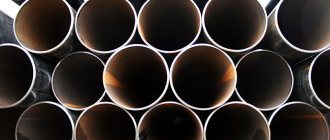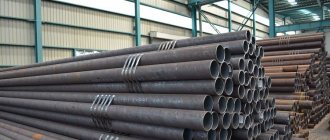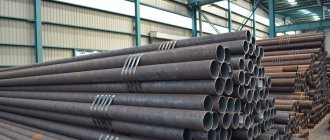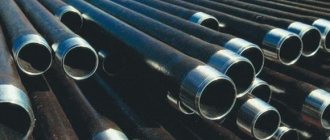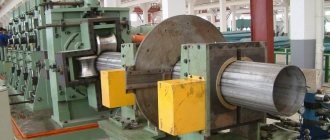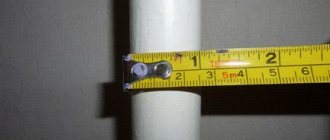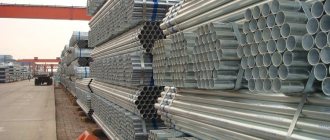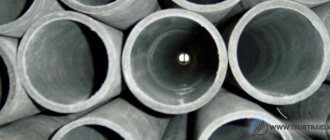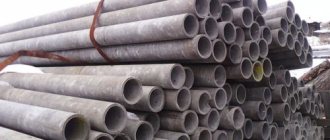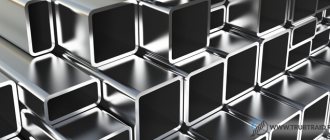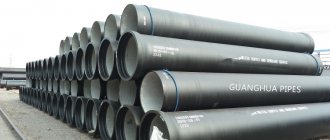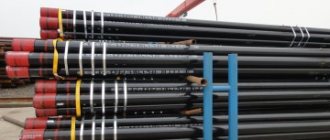What is a longitudinally welded pipe? According to state standards, this is a metal product that is welded from steel strips. In industrial cycles, the creation of such pipes involves several stages, such as shaping blanks from rolled sheets and welding such blanks into one piece.
The technical and operational characteristics of pipes in many ways indicate the quality characteristics of the material used, as well as the technology of the welding process. It is necessary to become more familiar with such metal products, which are manufactured in strict compliance with government regulations.
Main characteristics
A straight-seam electric-welded pipe is an all-metal product with a round or rectangular cross-section, manufactured purely in the factory using special rolling equipment. The production of the product is carried out by rolling sheet steel into a blank, which is welded using the direct joint method.
In accordance with the method of forming the blank, straight-seam pipes are divided into the following types:
- cold-formed,
- hot-deformed,
- cold rolled,
- cold drawn.
The weld seam has a longitudinal direction, which provides optimal strength parameters.
Fundamentally important: Pipes welded in this way do not allow for the possibility of mechanical bending, since this can lead to cracking or bending with loss of the initial configuration and strength properties.
In the manufacture of electric-welded pipes, carbon and low-carbon steel of calm, semi-quiet and boiling grades St1, St2, St3, St4, 08Yu and 22GYU are used.
Optimal strength properties of the product will be ensured if the steel contains:
- carbon - no more than 0.25%,
- sulfur - 0.056%,
- phosphorus - 0.046%.
In accordance with the type and grade of steel used, longitudinally welded metal products are divided into the following types:
- SP - modification made of mild steel,
- PS – modification made of semi-quiet steel,
- KP – modification made of boiling steel.
Belonging to one of the categories listed above is indicated in the markings applied to the surface of the pipes or mentioned in the accompanying documentation.
Straight-seam electric-welded pipes made of low-alloy and carbon steel, the diameter of which is 10-530 mm, are divided into the following groups:
- with a standardized chemical composition,
- with standardized mechanical properties,
- with standardized chemical composition and mechanical properties,
- with standardized test hydraulic pressure.
The use of the steel grades listed above cannot provide the finished product with sufficient resistance to corrosion processes. It is precisely on this basis that finished pipes, before or after completion of installation work, undergo special treatment, which consists of the use of special protective compounds or the application of classic paints and varnishes. (See also the article Corrosion protection of metal pipes: highlights.)
A separate category is galvanized welded pipe, for the production of which carbon steel grades 10, 20, 35, 45 and 15ХМ are used. Such metal products can be used for their intended purpose with minimal anti-corrosion treatment or, by and large, without it.
Finished products, regardless of the grade of the production materials used, must withstand long-term operating pressure of no more than 16 MPa. This property largely determines the scope of application of straight-seam welded pipes.
Scope of application
The range of electric-welded straight-seam pipes presented on the market has found wide use in the oil and gas refining and mining industries in accordance with the requirements set out in GOST 20295-85. Using these products, pipelines are built, both externally and buried. (See also the article Sewer system: highlights.)
Fundamentally important: The wall thickness of an underground pipeline must be at least 3 mm. Ground or above-ground pipelines are made of pipes with a wall thickness of no more than 2 mm.
The main area of application of longitudinally welded pipes was not chosen by chance, since these products have the following distinctive qualities:
- Ease of welding when making branches, corner and end joints, when installing shut-off valves, etc.
- Quite light weight compared to other products made of dark metals and, as a result, cheaper and easier to transport installation work.
- Reasonable price , which has a positive effect on the cost of the pipeline as a whole.
- Resistance to precipitation and other negative effects of environmental factors (subject to prior anti-corrosion preparation).
- Possibility of operation in virtually all climate zones without compromising the integrity of welded pipelines and seams as a whole.
Obviously, the scope of application of straight-seam welded pipes is not limited to the construction of oil and gas pipelines, since such products are characterized by versatility of application.
According to the scope of application, these pipes are divided into the following classes:
- Class 1 - equipped with products intended for transporting liquid and gaseous media under low pressure. In addition, such pipes are used everywhere in the construction of similar construction metal structures and scaffolding, which have a low mechanical load.
- Class 2 - used mainly in the construction of oil, gas and water pipelines. In addition, the use of metal products corresponding to this class extends to equipping companies in the chemical industry.
- Class 3 – used in the chemical and food industries. A distinctive feature of such products is their resistance to high temperatures and excessive short-term pressure.
- Class 4 - such pipes are used mainly for exploration of gas and oil fields.
- Class 5 is the optimal solution for assembling metal structures in demand in the machine-building and carriage-building industries. Less commonly, such pipes are used on construction sites for do-it-yourself assembly of scaffolding or frames for the construction of many construction projects.
- Class 6 – used only in the mechanical engineering industry.
Main sizes
purchases and instructions for choosing electric-welded pipes, as well as other rolled metal products, depend on the standard sizes. Let's consider the standard combinations of diameters and lengths that are used by domestic manufacturers.
Products with unmeasured length:
- From 2 meters or more with a cross-sectional diameter of up to 30 mm,
- From 4 meters or more with a diameter of 30-70 mm,
- From 5 meters or more with a diameter of at least 152 mm.
Products with measured length:
- 5-9 meters with a diameter of no more than 70 mm,
- 6-9 meters with a diameter of 70-219 mm,
- 10-12 meters with a diameter of no more than 426 mm.
In addition, electric-welded metal pipes of multiple lengths are produced, the multiple of which is more than 250 mm.
STATE STANDARD OF THE USSR UNION
ELECTRIC-WELDED STRAIGHT-WELMED STEEL PIPES
ASSORTMENT
GOST 10704-91
IPC PUBLISHING HOUSE OF STANDARDS
STATE STANDARD OF THE USSR UNION
ELECTRIC-WELDED STRAIGHT-WELMED STEEL PIPESAssortmentElectrically welded steel line-weld lubes. Range | GOST 10704-91 |
Date of introduction 01/01/93
1. This standard establishes the range of steel electric-welded straight-seam pipes.
2. The dimensions of the pipes must correspond to the table. 1.
3. According to the length of the pipe, they are made: of unmeasured length:
with a diameter of up to 30 mm - at least 2 m;
with a diameter of St. 30 to 70 mm - at least 3 m;
with a diameter of St. 70 to 152 mm - at least 4 m;
with a diameter of St. 152 mm - not less than 5 m.
At the request of the consumer, pipes of groups A and B according to GOST 10705 with a diameter of over 152 mm are manufactured with a length of at least 10 m; pipes of all groups with a diameter of up to 70 mm - a length of at least 4 m;
measured length:
with a diameter of up to 70 mm - from 5 to 9 m;
with a diameter of St. 70 to 219 mm - from 6 to 9 m;
with a diameter of St. 219 to 426 mm - from 10 to 12 m.
Pipes with a diameter over 426 mm are manufactured only in unmeasured lengths. By agreement between the manufacturer and the consumer, pipes with a diameter of over 70 to 219 mm can be manufactured from 6 to 12 m;
a multiple length of at least 250 mm and not exceeding the lower limit established for measuring pipes. The allowance for each cut is set to 5 mm (unless another allowance is specified) and is included in each multiplicity.
Table 1
| Outer diameter, mm | Theoretical weight of 1 m of pipes, kg, with wall thickness, mm | ||||||||||
| 1,0 | 1,2 | 1,4 | (1,5) | 1,6 | 1,8 | 2,0 | 2,2 | 2,5 | 2,8 | 3,0 | |
| 10 | 0,222 | 0,260 | * | * | * | * | * | * | * | * | * |
| 10,2 | 0,227 | 0,266 | — | — | — | — | — | — | — | — | — |
| 12 | 0,271 | 0,320 | 0,366 | 0,388 | 0,410 | — | — | — | — | — | — |
| 13 | 0,296 | 0,349 | 0,401 | 0,425 | 0,450 | — | — | — | — | — | — |
| 14 | 0,321 | 0,379 | 0,435 | 0,462 | 0,489 | — | — | — . | — | — | — |
| (15) | 0,345 | 0,408 | 0,470 | 0,499 | 0,529 | — | — | — | — | — | — |
| 16 | 0,370 | 0,438 | 0,504 | 0,536 | 0,568 | — | — | — | — | — | — |
| (17) | 0,395 | 0,468 | 0,539 | 0,573 | 0,608 | — | — | — | — | — | — |
| 18 | 0,419 | 0,497 | 0,573 | 0,610 | 0,719 | 0,789 | — | — | — | — | — |
| 19 | 0,444 | 0,527 | 0,608 | 0,647 | 0,687 | 0,764 | 0,838 | — | — | — | — |
| 20 | 0,469 | 0,556 | 0,642 | 0,684 | 0,726 | 0,808 | 0,888 | — | — | — | — |
| 21,3 | 0,501 | 0,595 | 0,687 | 0,732 | 0,777 | 0,866 | 0,952 | — | — | — | — |
| 22 | 0,518 | 0,616 | 0,711 | 0,758 | 0,805 | 0,897 | 0,986 | — | — | — | — |
| (23) | 0,543 | 0,645 | 0,746 | 0,795 | 0,844 | 0,941 | 1,04 | 1,13 | 1,26 | * | — |
| 24 | 0,567 | 0,675 | 0,780 | 0,832 | 0,884 | 0,985 | 1,09 | 1,18 | 1,33 | — | — |
| 25 | 0,592 | 0,704 | 0,815 | 0,869 | 0,923 | 1,03 | 1,13 | 1,24 | 1,39 | — | — |
| 26 | 0,617 | 0,734 | 0,849 | 0,906 | 0,963 | 1,07 | 1,18 | 1,29 | 1,45 | — | |
| 27 | 0,641 | 0,764 | 0,884 | 0,943 | 1,00 | 1,12 | 1.23 | 1,35 | 1,51 | — | |
| 28 | 0,666 | 0,793 | 0,918 | 0,980 | 1,04 | 1,16 | 1,28 | 1,40 | 1,57 | — | |
| 30 | 0,715 | 0,852 | 0,987 | 1,05 | 1,12 | 1,25 | 1,38 | 1,51 | 1,70 | — | |
| 32 | 0,765 | 0,911 | 1,06 | 1,13 | 1,20 | 1,34 | 1,48 | 1,62 | 1,82 | 2,02 | |
Continuation of the table. 1
| Outer diameter, mm | Theoretical weight of 1 m of pipes, kg, with wall thickness, mm | |||||||||
| 1,0 | 1,2 | 1,4 | (1,5) | 1,6 | 1,8 | 2,0 | 2,2 | 2,5 | 2,8 | |
| 33 | 0,789 | 0,941 | 1,09 | 1,17 | 1,24 | 1,38 | 1,53 | 1,67 | 1,88 | 2,09 |
| 33,7 | — | 0,962 | 1,12 | 1,19 | 1,27 | 1,42 | 1,56 | 1,71 | 1,92 | 2,13 |
| 35 | — | 1,00 | 1,16 | 1,24 | 1,32 | 1,47 | 1,63 | 1,78 | 2,00 | 2,22 |
| 36 | — | 1,03 | 1,19 | 1,28 | 1,36 | 1,52 | 1,68 | 1,83 | 2,07 | 2,29 |
| 38 | — | 1,09 | 1,26 | 1,35 | 1,44 | 1,61 | 1,78 | 1,94 | 2,19 | 2,43 |
| 40 | — | 1,15 | 1,33 | 1,42 | 1,52 | 1,70 | 1,87 | 2,05 | 2,31 | 2,57 |
| 42 | — | 1,21 | 1,40 | 1,50 | 1,59 | 1,78 | 1,97 | 2,16 | 2,44 | 2,71 |
| 44,5 | — | 1,28 | 1,49 | 1,59 | 1,69 | 1,90 | 2,10 | 2,29 | 2,59 | 2,88 |
| 45 | — | 1,30 | 1,51 | 1,61 | 1,71 | 1,92 | 2,12 | 2,32 | 2,62 | 2,91 |
| 48 | — | — | 1,61 | 1,72 | 1,83 | 2,05 | 2,27 | 2,48 | 2,81 | 3,12 |
| 48,3 | — | — | 1,62 | 1,73 | 1,84 | 2,06 | 2,28 | 2,50 | 2,82 | 3,14 |
| 51 | — | — | 1,71 | 1,83 | 1,95 | 2,18 | 2,42 | 2,65 | 2,99 | 3,33 |
| 53 | — | — | 1,78 | 1,91 | 2,03 | 2,27 | 2,52 | 2,76 | 3,11 | 3,47 |
| 54 | — | — | 1,82 | 1,94 | 2,07 | 2,32 | 2,56 | 2,81 | 3,18 | 3,54 |
| 57 | — | — | 1,92 | 2,05 | 2,19 | 2,45 | 2,71 | 2,97 | 3,36 | 3,74 |
| 60 | — | — | 2,02 | 2,16 | 2,30 | 2,58 | 2,86 | 3,14 | 3,55 | 3,95 |
| 63,5 | — | — | 2,14 | 2,29 | 2,44 | 2,74 | 3,03 | 3,33 | 3,76 | 4,19 |
| 70 | — | — | 2,37 | 2,53 | 2,70 | 3,03 | 3,35 | 3,68 | 4,16 | 4,64 |
Continuation of the table. 1
| Outer diameter, mm | Theoretical weight of 1 m of pipes, kg, with wall thickness, mm | |||||||||
| 1,0 | 1,2 | 1,4 | (1,5) | 1,6 | 1,8 | 2,0 | 2,2 | 2,5 | 2,8 | |
| 73 | * | * | 2,47 | 2,64 | 2,82 | 3,16 | 3,50 | 3,84 | 4,35 | 4,85 |
| 76 | — | — | 2,58 | 2,76 | 2,94 | 3,29 | 3,65 | 4,00 | 4,53 | 5,05 |
| 88 | — | — | — | — | 3,21 | 3,60 | 4,00 | 4,38 | 4,96 | 5,54 |
| 89 | — | — | — | — | 3,45 | 3,87 | 4,29 | 4,71 | 5,33 | 5,95 |
| 95 | * | — | — | — | — | — | 4,59 | — | 5,70 | — |
| 102 | * | * | * | — | — | 4,45 | 4,93 | 5,41 | 6,13 | 6,85 |
| 108 | * | — | — | — | — | 4,71 | 5,23 | 5,74 | 6,50 | 7,26 |
| 114 | — | — | — | — | — | 4,98 | 5,52 | 6,07 | 6,87 | 7,68 |
| 127 | — | — | — | — | — | 5,56 | 6,17 | 6,77 | 7,68 | 8,58 |
| 133 | — | — | — | — | — | 5,82 | 6,46 | 7,10 | 8,05 | 8,99 |
| 140 | — | — | — | — | — | 6,13 | 6,81 | 7,48 | 8,48 | 9,47 |
| 152 | * | — | — | — | — | 6,67 | 7,40 | 8,13 | 9,22 | 10,30 |
| 159 | — | — | — | — | — | 6,98 | 7,74 | 8,51 | 9,65 | 10,79 |
| 168 | — | — | — | — | — | 7,38 | 8,19 | 9,00 | 10,20 | 11,41 |
| 177,8 | — | — | — | — | — | 7,81 | 8,67 | 9,53 | 10,81 | 12.08 |
| 180 | — | — | — | — | — | — | — | — | — | — |
| 193,7 | — | — | — | — | — | — | 9,46 | 10,39 | 11,79 | 13,18 |
| 219 | — | — | — | — | — | — | — | — | 13,35 | 14,93 |
| 244,5 | — | — | — | — | — | — | — | — | — | — |
Continuation of the table. 1
| Outer diameter, mm | Theoretical weight of 1 m of pipes, kg, with wall thickness, mm | ||||||||||
| 3,0 | 3,2 | 3,5 | 3,8 | 4,0 | 4,5 | 5,0 | 5,5 | 6,0 | 7,0 | 8,0 | |
| 26 | — | — | * | * | * | * | * | * | * | * | * |
| 27 | — | — | — | — | — | — | — | — | — | — | — |
| 28 | — | — | — | — | — | — | — | — | — | — | — |
| 30 | — | — | — | — | — | — | — | — | — | — | — |
| 32 | 2,15 | — | — | — | — | — | — | — | — | — | — |
| 33 | 2,22 | — | — | — | — | — | — | — | — | — | — |
| 33,7 | 2,27 | — | — | — | — | — | — | — | — | — | — |
| 35 | 2,37 | — | — | — | — | — | — | — | — | — | — |
| 36 | 2,44 | — | — | — | — | — | — | — | * | * | * |
| 38 | 2,59 | — | * | * | * | * | * | * | * | * | * |
| 40 | 2,74 | — | — | — | — | — | * | * | * | * | * |
| 42 | 2,89 | — | — | — | — | — | — | — | — | — | * |
| 44,5 | 3,07 | — | — | — | — | — | — | — | — | — | — |
| 45 | 3,11 | — | — | — | — | — | — | — | — | — | * |
| 48 | 3,33 | 3,54 | 3,84 | — | — | — | — | — | — | — | — |
| 48,3 | 3,35 | 3,56 | 3,87 | — | — | — | — | — | — | — | — |
| 51 | 3,55 | 3,77 | 4,10 | — | — | — | — | — | — | — | — |
| 53 | 3,70 | 3,93 | 4,27 | — | — | — | — | — | — | — | — |
| 54 | 3,77 | 4,01 | 4,36 | — | — | — | — | — | — | — | — |
Continuation of the table. 1
| Outer diameter, mm | Theoretical weight of 1 m of pipes, kg, with wall thickness, mm | |||||||||||
| 3,0 | 3,2 | 3,5 | 3,8 | 4,0 | 4,5 | 5,0 | 5,5 | 6,0 | 7,0 | 8,0 | 9,0 | |
| 57 | 4,00 | 4,25 | 4,62 | * | * | * | * | * | * | * | * | * |
| 60 | 4,22 | 4,48 | 4,88 | 5,27 | — | — | — | — | — | — | — | — |
| 63,5 | 4,48 | 4,76 | 5,18 | 5,59 | — | — | — | — | — | — | — | — |
| 70 | 4,96 | 5,27 | 5,74 | 6,20 | 6,51 | — | — | — | — | — | — | — |
| 73 | 5,18 | 5,51 | 6,00 | 6,48 | 6,81 | — | — | — | — | — | — | — |
| 76 | 5,40 | 5,75 | 6,26 | 6,26 | 7,10 | 7,93 | 8,75 | 9,56 | * | — | — | — |
| 83 | 5,92 | 6,30 | 6,86 | 7,42 | 7,79 | 8,71 | 9,62 | 10,51 | — | — | — | — |
| 89 | 6,36 | 6,77 | 7,38 | 7,98 | 8,38 | 9,38 | 10,36 | 11,33 | — | — | — | — |
| 95 | — | 7,24 | — | — | — | — | 11,10 | — | — | — | — | — |
| 102 | 7,32 | 7,80 | 8,50 | 9,20 | 9,67 | 10,82 | 11,96 | 13,09 | — | — | — | — |
| 108 | 7,77 | 8,27 | 9,02 | 9,76 | 10,26 | 11,49 | 12,70 | 13,90 | — | — | — | — |
| 114 | 8,21 | 8,74 | 9,54 | 10,33 | 10,85 | 12,15 | 13,44 | 14,72 | — | — | — | — |
| 127 | 9,17 | 9,77 | 10,66 | 11,55 | 12,13 | 13,59 | 15,04 | 16,48 | — | — | — | — |
| 133 | 9,62 | 10,24 | 11,18 | 12,11 | 12,73 | 14,26 | 15,78 | 17,29 | — | — | — | — |
| 140 | 10,14 | 10,80 | 11,78 | 12,76 | 13,42 | 15,04 | 16,65 | 18,24 | — | — | — | — |
| 152 | 11,02 | 11,74 | 12,82 | 13,89 | 14,60 | 16,37 | 18,13 | 19,87 | — | — | — | — |
| 159 | 11,54 | 12,30 | 13,42 | 14,52 | 15,29 | 17,15 | 18,99 | 20,82 | 22,64 | 26,24 | 26,24 | — |
| 168 | 12,21 | 13,01 | 14,20 | 15,39 | 16,18 | 18,14 | 20,10 | 22,04 | 23,97 | 27,79 | 31,57 | — |
| 177,8 | 12,93 | 13,78 | 15,04 | 16,31 | 17,14 | 19,23 | 21,31 | 23,37 | 25,42 | 29,49 | 33,50 | — |
| 180 | — | — | — | — | 17,36 | — | 21,58 | — | — | — | — | — |
| 193,7 | 14,11 | 15,03 | 16,42 | 17,80 | 18,71 | 21,00 | 23,27 | 25,53 | 27,77 | 32,23 | 36,64 | — |
| 219 | 15,98 | 17,03 | 18,60 | 20,17 | 21,21 | 23,80 | 26,39 | 28,96 | 31,52 | 36,60 | 41,63 | 46,61 |
| 244,5 | 17,87 | 19,04 | 20,80 | 22,56 | 23,72 | 26,63 | 29,53 | 32,42 | 35,42 | 41,00 | 46,66 | 52,27 |
| 273 | — | — | 23,26 | 25,23 | 26,54 | 29,80 | 23,05 | 36,28 | 39,51 | 45,92 | 52,28 | 58,60 |
Continuation of the table. 1
| Outer diameter, mm | Theoretical weight of 1 m of pipes, kg, with wall thickness, mm | |||||||||
| 3,5 | 3,8 | 4,0 | 4,5 | 5,0 | 5,5 | 6,0 | 7,0 | 8,0 | 9,0 | |
| 325 | * | * | 31,67 | 35,57 | 39,46 | 43,34 | 47,20 | 54,90 | 62,54 | 70,14 |
| 355,6 | — | — | 34,68 | 38,96 | 43,23 | 47,49 | 51,73 | 60,18 | 68,58 | 76,93 |
| 377 | — | — | 36,79 | 41,34 | 45,87 | 50,39 | 54,90 | 63,87 | 72,80 | 81,68 |
| 406,4 | — | — | 39,70 | 44,60 | 49,50 | 54,38 | 59,25 | 68,95 | 78,60 | 88,20 |
| 426 | — | — | 41,63 | 46,78 | 51,91 | 57,04 | 62,15 | 72,33 | 82,47 | 92,55 |
| (478) | — | — | — | — | 58,32 | 64,09 | 69,84 | 81,31 | 92,73 | 104,10 |
| 530 | — | — | — | — | 64,74 | 71,14 | 77,54 | 90,29 | 102,99 | 115,64 |
| 630 | — | — | — | — | — | — | — | 107,55 | 122,72 | 137,83 |
| 720 | — | — | — | — | — | — | — | 123,09 | 140,47 | 157,81 |
| 820 | — | — | — | — | — | — | — | 140,35 | 160,20 | 180,00 |
| 920 | — | — | — | — | — | — | — | 157,61 | 179,93 | 202,20 |
| 1020 | — | — | — | — | — | — | — | — | 199,66 | 224,39 |
| 1120 | — | — | — | — | — | — | — | — | 219,39 | 246,59 |
| 1220 | — | — | — | — | — | — | — | — | — | 268,79 |
| 1420 | — | — | — | — | — | — | — | — | — | — |
Continuation of the table. 1
| Outer diameter, mm | Theoretical weight of 1 m of pipes, kg, with wall thickness, mm | ||||||||||
| 10 | 11 | 12 | 13 | 14 | 16 | (17) | 17,5 | 18 | 19 | 20 | |
| 325 | * | — | — | — | — | — | — | — | — | — | — |
| 355,6 | 85,23 | — | — | — | — | — | — | — | — | — | — |
| 377 | 90,51 | — | — | — | — | — | — | — | — | — | — |
| 406,4 | 97,76 | 107,26 | 116,72 | — | — | — | — | — | — | — | — |
| 426 | 102,59 | 112,58 | 122,52 | — | — | — | — | — | — | — | — |
| (478) | 115,42 | 126,69 | 137,91 | — | — | — | — | — | — | — | — |
| 530 | 128,24 | 140,79 | 153,30 | 165,75 | 178,15 | 202,82 | 215,07 | 221,18 | 227,28 | 239,44 | 251,55 |
| 630 | 152,90 | 167,92 | 182,89 | 197,81 | 212,68 | 242,27 | 257,00 | 264,34 | 271,67 | 286,30 | 300,87 |
| 720 | 175,10 | 192,33 | 209,52 | .226,66 | 243,75 | 277,79 | 294,73 | 303,18 | 311,62 | 328,47 | 345,26 |
| 820 | 199,76 | 219,46 | 239,12 | 258,72 | 278,28 | 317,25 | 336,65 | 346,34 | 356,01 | 375,32 | 394,58 |
| 920 | 224,42 | 246,59 | 268,71 | 290,78 | 312,81 | 356,70 | 378,58 | 389,50 | 400,40 | 422,18 | 443,91 |
| 1020 | 249,08 | 273,72 | 298,31 | 322,84 | 347,33 | 396,16 | 420,50 | 432,65 | 444,79 | 469,04 | 493,23 |
| 1120 | 273.74 | 300,85 | 327,90 | 354,90 | 381,86 | 435,62 | 462,43 | 475,81 | 481,19 | 515,89 | 542,55 |
| 1220 | 298,40 | 327,97 | 357,49 | 386,96 | 416,38 | 475,08 | 504,35 | 518,97 | 533,58 | 562,75 | 591,88 |
| 1420 | 347,73 | 382,23 | 416,68 | 451,08 | 485,44 | 554,00 | 588,20 | 605,29 | 622,36 | 656,46 | 690,52 |
Continuation of the table. 1
| Outer diameter, mm | Theoretical weight of 1 m of pipes, kg, with wall thickness, mm | |||||||||||
| 21 | 22 | 23 | 24 | 25 | 26 | 27 | 28 | 29 | 30 | 31 | 32 | |
| 530 | 263,61 | 275,62 | 287,58 | 299,49 | — | — | — | — | — | — | * | — |
| 630 | — | — | — | — | — | — | — | — | — | — | * | — |
| 720 | 362,01 | 378,70 | 395,35 | 411,95 | 411,95 | 428,49 | 444,99 | 461,44 | 477,84 | 510,49 | — | — |
| 820 | 413,79 | 432,96 | 452,07 | 471,13 | 490,15 | 509,11 | 528,03 | 546,89 | 565,71 | 584,48 | — | — |
| 920 | — | — | — | — | — | — | — | — | — | — | * | — |
| 1020 | 517,37 | 541,47 | 565,51 | 589,51 | 613,45 | 637,35 | 661,20 | 685,00 | 708,75 | 732,45 | 756,10 | 779,70 |
| 1120 | — | — | — | — | — | — | — | — | — | — | — | — |
| 1220 | — | — | — | — | — | — | — | — | — | — | — | — |
| 1420 | — | — | — | — | — | — | — | — | — | — | — | — |
Notes:
1. When manufacturing pipes in accordance with GOST 10706, the theoretical weight increases by 1% due to the strengthening of the seam.
2. By agreement between the manufacturer and the consumer, pipes with dimensions of 41.5 x 1.5-3.0 are manufactured; 43ґ1.0; 1.53.0; 43.5ґ1.5-3.0; 52ґ2.5; 69.6ґ1.8; 111.8ґ2.3; 146.1ґ5.3; 6.5; 7.0; 7.7; 8.5; 9.5; 10.7; 152.4ґ1.9; 2.65; 168ґ2.65; 177.3ґ1.9; 198ґ2.8; 203ґ2.65; 299ґ4.0; 530ґ7.5; 720ґ7.5; 820ґ8.5; 1020ґ9.5; 15.5; 1220ґ13.5; 14.6; 15.2 mm, as well as with intermediate wall thickness and diameters within the limits of the table. 1.
3. Pipe sizes enclosed in brackets are not recommended for new design.
3.1. Pipes of measured and multiple lengths are manufactured in two accuracy classes:
I - with cutting ends and deburring;
II - without facing and deburring (with cutting in the mill line).
3.2. Maximum deviations along the length of measuring pipes are given in table. 2.
table 2
| Pipe length, m | Maximum deviations along the length of measuring pipes, mm, classes | |
| I | II | |
| Up to 6 incl. | +10 | +50 |
| St. 6 | +15 | +70 |
3.3. Maximum deviations along the total length of multiple pipes should not exceed:
+ 15 mm - for pipes of class I accuracy;
+ 100 mm - for pipes of class II accuracy.
3.4. At the consumer's request, pipes of measured and multiple lengths of class II accuracy must have ends with flanged ends on one or both sides.
4. Maximum deviations for the outer diameter of the pipe are given in table. 3.
Table 3
| Outer diameter of pipes, mm | Limit deviations in outer diameter with precision manufacturing | |
| ordinary | increased | |
| 10 | ±0.2 mm | * |
| From 10 to 30 incl. | ±0.3 mm | ±0,25 |
| » 30 » 51 » | ±0.4 mm | ±0,35 |
| » 51 » 193,7 » | ±0,8 % | ±0,7 % |
| » 193,7 » 426 » | ±0,75 % | ±0,65 % |
| » 426 » 1020 » | ±0,7 % | ±0,65 % |
| » 1020 | ±0,6% | ±6.0 mm |
Note.
For diameters controlled by perimeter measurements, the largest and smallest perimeter limits are rounded to the nearest 1 mm.
5. At the request of the consumer, pipes in accordance with GOST 10705 are manufactured with a one-sided or offset tolerance on the outer diameter. One-sided or shifted tolerance should not exceed the sum of the maximum deviations given in table. 3.
6. Maximum deviations in wall thickness must correspond to:
± 10% - for pipe diameters up to 152 mm;
GOST 19903 - for pipe diameters over 152 mm for the maximum sheet width of normal accuracy.
By agreement between the consumer and the manufacturer, it is allowed to manufacture pipes with a one-sided tolerance for wall thickness, while the one-sided tolerance should not exceed the sum of the maximum deviations for wall thickness.
7. For pipes with a diameter of over 76 mm, a thickening of the wall at the burr by 0.15 mm is allowed.
8. Pipes for pipelines with a diameter of 478 mm and more, manufactured in accordance with GOST 10706, are supplied with maximum deviations for the outer diameter of the ends given in table. 4.
Table 4
mm
| Pipe outer diameter | Maximum deviations in the outer diameter of the ends for manufacturing accuracy | |
| n increased | ordinary | |
| From 478 to 720 incl. | ±1,5 | ±2,5 |
| St. 720 » 1020 » | ±2,0 | ±2,5 |
| » 1020 | ±3,5 | ±4,0 |
9. The out-of-roundness and uniformity of pipes with a diameter of up to 530 mm inclusive, manufactured in accordance with GOST 10705, must be no more than the maximum deviations for the outer diameter and wall thickness, respectively.
Pipes with a diameter of 478 mm or more, manufactured in accordance with GOST 10706, must be of three accuracy classes for ovality. The ovality of the pipe ends should not exceed:
1% of the outer diameter of pipes for 1st accuracy class;
1.5% of the outer diameter of pipes for 2nd accuracy class;
2% of the outer diameter of pipes for 3rd accuracy class.
The ovality of the ends of pipes with a wall thickness of less than 0.01 outer diameter is established by agreement between the manufacturer and the consumer.
10. The curvature of pipes manufactured according to GOST 10705 should not exceed 1.5 mm per 1 m of length. At the request of the consumer, the curvature of pipes with a diameter of up to 152 mm should be no more than 1 mm per 1 m of length.
The total curvature of pipes manufactured in accordance with GOST 10706 should not exceed 0.2% of the pipe length. The curvature per 1 m length of such pipes is not determined.
11. Technical requirements must comply with GOST 10705 and GOST 10706.
Examples of symbols:
Pipe with an outer diameter of 76 mm, a wall thickness of 3 mm, measured length, class II length accuracy, made of St3sp steel, manufactured according to group B of GOST 10705-80:
The same, increased accuracy in outer diameter, length, multiple of 2000 mm, 1st accuracy class in length, from steel grade 20, manufactured according to group B of GOST 10705-80:
Pipe with an outer diameter of 25 mm, a wall thickness of 2 mm, a length multiple of 2000 mm, class II accuracy in length, manufactured according to group D GOST 10705-80;
Pipe with an outer diameter of 1020 mm, increased manufacturing accuracy, wall thickness 12 mm, increased accuracy in the outer diameter of the ends, 2nd class accuracy in ovality, unmeasured length, made of St3sp steel, manufactured according to group B of GOST 10706-76
Note.
In the symbols of pipes that have undergone heat treatment throughout the entire volume, the letter T is added after the words “pipe”; pipes that have undergone local heat treatment of the weld, the letter L is added.
INFORMATION DATA
1. DEVELOPED AND INTRODUCED by the USSR Ministry of Metallurgy
DEVELOPERS
V. P. Sokurenko, Ph.D. tech. sciences; V. M. Vorona, Ph.D. tech. Sciences; P. N. Ivshin, Ph.D. tech. Sciences; N. F. Kuzenko, V. F. Ganzina
2. APPROVED AND ENTERED INTO EFFECT by Resolution of the Committee for Standardization and Metrology of the USSR dated November 15, 1991 No. 1743
3. INSTEAD GOST 10704-76
4. REFERENCE REGULATIVE AND TECHNICAL DOCUMENTS
| Designation of the referenced technical document | Item number |
| GOST 10705-80 | 3, 5, 9, 11 |
| GOST 10706-76 | 8, 9, 11 |
| GOST 19903-74 | 6 |
5. REPUBLICATION. December 1996
Electric welded pipes
| Electric-welded round pipes GOST: 10704-91, TU 10705-80 | |||
| Name | Wall thickness, mm | steel grade | Length, mm |
| Straight-seam pipe 20x1.5mm | 1,5 | 2-3PS/SP | 6000 |
| Straight-seam pipe 25x1.5mm | 1,5 | 2-3PS/SP | 6000 |
| Straight-seam pipe 28x1.5mm | 1,5 | 2-3PS/SP | 6000 |
| Straight-seam pipe 32x1.5mm | 1,5 | 2-3PS/SP | 6000 |
| Straight-seam pipe 38x1.5mm | 1,5 | 2-3PS/SP | 6000 |
| Straight-seam pipe 42x1.5mm | 1,5 | 2-3PS/SP | 6000 |
| Straight-seam pipe 45x1.5mm | 1,5 | 2-3PS/SP | 6000 |
| Straight-seam pipe 48x1.5mm | 1,5 | 2-3PS/SP | 6000 |
| Straight-seam pipe 51x1.5mm | 1,5 | 2-3PS/SP6m | 6000 |
| Straight-seam pipe 57x3mm | 3/3,5 | 2-3PS/SP | 10000-11700 |
| Straight-seam pipe 76x3.5mm | 3,5/4 | 2-3PS/SP | 10000-11700 |
| Straight-seam pipe 89x3.5mm | 3,5/4 | 2-3PS/SP | 10000-11700 |
| Straight-seam pipe 102x3.5mm | 3,5/4 | 2-3PS/SP | 10000-11700 |
| Straight-seam pipe 108x3.5mm | 3,5/4 | 2-3PS/SP | 10000-11700 |
| Straight-seam pipe 114x4mm | 4/4,5 | 2-3PS/SP | 10000 |
| Straight-seam pipe 133x4mm | 4/4,5 | 2-3PS/SP | 11700 |
| Straight-seam pipe 159x4mm | 4/5/6 | 2-3PS/SP | 11700 |
| Straight-seam pipe 219x5mm | 5/6/7 | 2-3PS/SP | 11700 |
| Straight-seam pipe 273x5mm | 5/6/7/8 | 2-3PS/SP | 11700 |
| Straight-seam pipe 325x6mm | 6/7/8 | 2-3PS/SP | 11700 |
| Straight-seam pipe 377x6mm | 6/7/8 | 2-3PS/SP | 11700 |
| Straight-seam pipe 426x6mm | 6/7/8/9/10 | 2-3PS/SP | 11700 |
| Straight-seam pipe 530x7mm | 7/8 | 2-3PS/SP | 11700 |
| Straight-seam pipe 630x8mm | 8/10 | 2-3PS/SP | 11700 |
| Electric-welded round pipes GOST: 20295 | |||
| Straight-seam pipe 530x8mm | 8 | 17G1S | 11700 |
| Straight-seam pipe 530×10mm | 10 | 17G1S | 11700 |
| Straight-seam pipe 630×8mm | 8/10 | 17G1S | 11700 |
| Straight-seam pipe 820×12mm | 12 | 17G1S | 11700 |
| Straight-seam pipe 1020×10mm | 10/12 | 17G1S | 11700 |
| Galvanized electric-welded round pipes GOST: 3262-75, 10704-91 | |||
| Name | Wall thickness, mm | steel grade | Length, mm |
| Galvanized straight-seam pipe. 57x3.5 | 3,5 | 2-3PS/SP | 7000-10000 |
| Galvanized straight-seam pipe. 76x3.5 | 3,5 | 2-3PS/SP | 7000-10000 |
| Galvanized straight-seam pipe. 89x3.5 | 3,5 | 2-3PS/SP | 7000-10000 |
| Galvanized straight-seam pipe. 108x3.5 | 3,5/4 | 2-3PS/SP | 7000-10000 |
| Galvanized straight-seam pipe. 133x4 | 4/4,5 | 2-3PS/SP | 7000-10000 |
| Galvanized straight-seam pipe. 159x4 | 4/4,5/5 | 2-3PS/SP | 7000-10000 |
| Galvanized straight-seam pipe. 219x6 | 6 | 2-3PS/SP | 7000-10000 |
Pipes are used mainly for laying pipelines for various purposes.
In the case where these structures are used to transport liquid or gaseous substances, pipes for them are selected in accordance with the impact on them. If the pipeline is intended for aggressive chemicals, then both the coating and the pipe itself will meet these requirements. Electric welded pipe is also used where pressure resistance is required from the pipeline. Seamless pipes are especially often used for such purposes. They are produced using the cold-formed method. Due to this, the pipes are especially durable and resistant to temperature changes. In addition to the construction of pipelines, pipes are also used in other areas of production. For the construction of buildings, pipe structures usually serve as load-bearing structures. Electric welded pipe used for this purpose most often has a rectangular rather than a round cross-section. Since this form will give it greater rigidity and stability. And for water supply in the same building, electric-welded round pipes can also be used. Only in this case the purpose of their use will be somewhat different. They will make up the building's water and gas pipeline system.
Our organization is ready to offer the following type of pipe metal:
- seamless steel pipe;
- hot-formed seamless steel pipe;
- cold-formed seamless steel pipe;
- water and gas pipeline (VGP);
- straight-seam electric-welded steel pipe;
- hot-deformed straight-seam electric-welded steel pipe;
- cold-deformed straight-seam electric-welded steel pipe;
- spiral welded electric welded steel pipe;
We also have in stock a galvanized steel round pipe on the surface of which a thin layer of zinc is applied. Thanks to galvanizing, the pipe acquires anti-corrosion properties and lasts much longer.
There are a large number of electric-welded pipes, but the principle of their division is the presence of a galvanized coating. Electric-welded galvanized pipes are the type of pipes most in demand among various enterprises, especially among construction companies.
The reason for the high demand for these products lies in the widespread use of galvanized electric-welded pipes, namely:
- in the construction of metal structures and billboards;
- use during the installation of all types of utility networks, for example, sewerage, water supply;
- use in transportation of all kinds of chemicals, etc.
The galvanizing procedure for electric-welded pipes improves their technical characteristics, making them more resistant to corrosion, stronger and more durable. In addition, pipes of this type are environmentally friendly, light weight and low cost. Galvanized pipes are produced in accordance with the standards GOST 10705-80 and GOST 10704-91 from carbon steel 15ХМ, 45, 35, 20, 10. Pipes are made from strips or rolled sheets using electric welding and forming. Pipes with a rectangular or square cross-section also refer to electric-welded pipes.
Straight-seam galvanized pipe is a pipe produced by welding with a straight joint running parallel to the axis of the pipe. The length of galvanized pipes is made in the range of 4-12 meters. Maximum weight deviations should not go beyond +8, -8%. Water and gas pipes can have normal accuracy and increased accuracy; they are made from steels in accordance with GOST 1050, GOST 380 without standardization of chemical composition and mechanical properties. Pipes are used in heating systems, gas and water pipelines, and in the production of parts for structures in these areas.
An electric welded pipe with a spiral seam is called spiral seam. They are made with internal and external seams. In this type of pipe, one circumferential seam and a transverse seam at the joint of the rolls, which are made by double-sided welding, are allowed. Pipes with a diameter of 1420 mm can have four transverse seams from the joint of the sheets. The length of spiral welded pipes can be 10-12 meters.
Depending on the thickness of the pipe wall, they are divided into ordinary, reinforced and lightweight. The wall thickness is regulated by GOST 3262-75. At the consumer's request, on reinforced pipes, as well as on ordinary pipes with a bore of more than 10 mm, threads can be applied to both ends of the pipe. Also, galvanized electric welded pipes can be supplied without a coupling, with a coupling, without thread, or with thread.
In the production of pipes, low-alloy or high-carbon steel is used, and the alloying elements are chromium or manganese. The amount of impurities should not be higher than 2.5%, but when manufacturing special-purpose pipes, the impurity content increases to 10%. To increase the service life of electric-welded pipes, in addition to galvanizing, polymer and bitumen coatings are used. The combination of steel grade, alloying elements and profile shape, together with compliance with GOST standards, determines the reliability and strength of metal electric-welded pipes.
There are a large number of electric-welded pipes, but the principle of their division is the presence of a galvanized coating. Electric-welded galvanized pipes are the type of pipes most in demand among various enterprises, especially among construction companies.
The reason for the high demand for these products lies in the widespread use of galvanized electric-welded pipes, namely:
- in the construction of metal structures and billboards;
- use during the installation of all types of utility networks, for example, sewerage, water supply;
- use in transportation of all kinds of chemicals, etc.
The galvanizing procedure for electric-welded pipes improves their technical characteristics, making them more resistant to corrosion, stronger and more durable. In addition, pipes of this type are environmentally friendly, light weight and low cost. Galvanized pipes are produced in accordance with the standards GOST 10705-80 and GOST 10704-91 from carbon steel 15ХМ, 45, 35, 20, 10. Pipes are made from strips or rolled sheets using electric welding and forming. Pipes with a rectangular or square cross-section also refer to electric-welded pipes.
Straight-seam galvanized pipe is a pipe produced by welding with a straight joint running parallel to the axis of the pipe. The length of galvanized pipes is made in the range of 4-12 meters. Maximum weight deviations should not go beyond +8, -8%. Water and gas pipes can have normal accuracy and increased accuracy; they are made from steels in accordance with GOST 1050, GOST 380 without standardization of chemical composition and mechanical properties. Pipes are used in heating systems, gas and water pipelines, and in the production of parts for structures in these areas.
An electric welded pipe with a spiral seam is called spiral seam. They are made with internal and external seams. In this type of pipe, one circumferential seam and a transverse seam at the joint of the rolls, which are made by double-sided welding, are allowed. Pipes with a diameter of 1420 mm can have four transverse seams from the joint of the sheets. The length of spiral welded pipes can be 10-12 meters.
Depending on the thickness of the pipe wall, they are divided into ordinary, reinforced and lightweight. The wall thickness is regulated by GOST 3262-75. At the consumer's request, on reinforced pipes, as well as on ordinary pipes with a bore of more than 10 mm, threads can be applied to both ends of the pipe. Also, galvanized electric welded pipes can be supplied without a coupling, with a coupling, without thread, or with thread.
In the production of pipes, low-alloy or high-carbon steel is used, and the alloying elements are chromium or manganese. The amount of impurities should not be higher than 2.5%, but when manufacturing special-purpose pipes, the impurity content increases to 10%. To increase the service life of electric-welded pipes, in addition to galvanizing, polymer and bitumen coatings are used. The combination of steel grade, alloying elements and profile shape, together with compliance with GOST standards, determines the reliability and strength of metal electric-welded pipes.
See also: tool steels, rectangular profile pipe
GYUR-Stal specialists will advise you free of charge on the assortment and select the right type of rolled metal that will meet the requirements of your project.
Check the cost and availability of delivery with GYUR-Stal specialists by phone: 8-499-258-08-21 or leave a Request right now.
The scope of application of pipes can be easily determined by the class marking:
Class 1 – combined characteristics that allow the use of pipes as casings and main pipelines for heat supply purposes.
Class 2 - pipes with standard quality characteristics, capable of operating under normal conditions (at non-critical temperatures, average operating pressure, and also under standard urban network congestion).
Class 3 – pipes made of reinforced steel, usually produced with high weld strength. The product is able to withstand pressure changes and temperature changes. These are industrial pipes that can be found at nuclear power plants and other similar enterprises.
Class 4 – electric-welded steel pipe, made from steel of a special composition, characterized by high resistance to corrosion.
Class 5 - based on the final orientation that the manufacturer included in the product, electric-welded steel pipes of the specified class will be used either in mechanical engineering or as railway cars.
Class 6 - impact-resistant, hard-to-bend pipes that are used as tanks or parts of units.
